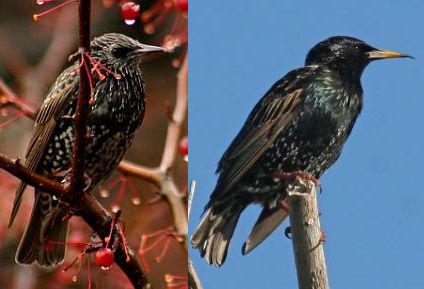
16 February 2008
Today’s blog is a costume drama replete with history and the stars are “Star-lings.”
Have you noticed that European starlings are changing into their sleek spring costumes? I have.
To show you what I mean, I’ve put two of Chuck Tague’s pictures side by side. On the left is a starling in non-breeding plumage. His feathers look very speckled and his beak is dull gray-brown. On the right is a starling in spring breeding plumage. The speckled tips on his breast and head feathers have worn off so he looks glossy black-green – almost oily – and his beak is yellow.
Now, for the history and drama.
History:
Starlings are called “European” for good reason. They didn’t live in North America until humans introduced them from the 1870s to 1890s. Two famous releases totaling 100 starlings were made in New York’s Central Park in 1890-1891 by Eugene Scheiffelin. Legend says that he chose starlings because he wanted every bird mentioned by Shakespeare to live in the U.S. — but that isn’t so. Instead he was fulfilling his role as chair of the American Acclimatization Society (AAS), “dedicated to introducing European flora and fauna into North America for economic and cultural reasons.” Within a decade, people began to realize that this goal was a bad idea.
During the AAS era, Shakespeare was never mentioned as a motivating force for the introductions. 60 years pass before anyone says Shakespeare is the reason and at that point Sheiffelin had been dead for 40 years. (Click here to find out more.)
Drama:
Starlings do make an appearance in Shakespeare, however, because they can mimic many sounds including human voices and the calls of other birds. In the wild they sound like this, but people can teach them to say many things. See Techno the starling’s video.
In Shakespeare’s Henry IV, Part I, Hotspur is angry at the king and says to Worcester,
“He said he would not ransom Mortimer,
Forbade my tongue to speak of Mortimer,
But I will find him when he lies asleep,
And in his ear I’ll holloa “Mortimer.”
Nay;
I’ll have a starling shall be taught to speak
Nothing but “Mortimer,” and give it him
To keep his anger still in motion.”
Today our starling population ranges from Alaska to Mexico and is estimated at 200 million.
200 million! That’s a lot more “copies” circulating in North America than you’re likely to find of Henry IV, Part I.